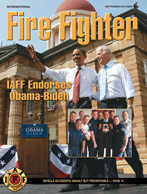Kerry BohananApparatus Operator1975 - 2001 Fire has been a friend and enemy to mankind for many centuries. In early times when fire threatened man, he had no mechanical means of extinguishing fire. So, he would try to beat at the fire with sticks and branches, he would hide or try to escape from it. When the “New Country” was settled and small communities began to form, there was a need for some kind of protection from that deadly enemy – FIRE!!! The first defense against fire in those early days was by means of the ‘bucket brigade’. Everyone was required to have a fire bucket in their home. When the fire alarm sounded, everyone ‘turned-to’ with their buckets. With the mechanical age came the invention of the hand pumper fire apparatus. These fire engines were usually hand-drawn. As the The City of This article is dedicated to the people of the Albany Fire Department, past and present. Thus, in January of 1869, an organization was formed and a hand-drawn pumper was purchased. The new organization was know as “Albany Engine Company No. 1, and is recorded as the first organized volunteer fire department of The organization of Albany Engine Co. No.1 remained about the same for the next six years except for minor changes in the personnel. During an election, Liggett was elected to serve as the President of Albany Engine Co. No. 1. In the spring of 1875, an effort was made by Claib Stewart to organize a Hook & Ladder Company. Claib enlisted the services of William Miller, a brother-in-law to L.E. Blain, and together they collected the names of fifty men who would join the newly formed company. A meeting was called, and when the new organization got together they were not in favor of a hook & ladder company, but were more in favor of organizing another engine company. The problem of raising a sufficient amount of money to purchase the new steamer was solved when the businessmen offered to subscribe stock when the company became incorporated. The next meeting of the company was held September 13, 1875 when the organization was finally completed by the election of the following officers: President, Dr. G.W. Gray; Secretary, Jos G. Evans; Treasurer, P. H. Raymond; Financial Secretary, L. H. Montanye; Foreman, William Miller; 1st Assistant, Ed Carter; and C. C. Chery as 2nd Assistant. The company incorporated At a meeting Also noted at this December meeting was the fact that enough stock had been sold to place the order for the new steam engine. So, Linn Engine Co. No. 2 placed the order for the new engine to be shipped from Finally, on an early spring day in May of 1876, the new steam engine arrived in the Since this was The great demonstration occurred on The next event for that big day was the testing of the new steamer. Starting with cold water in the boiler, she showed 5 pounds of steam in 4 ½ minutes and working steam in nine minutes. The new little steamer showed water and threw a solid stream 221 ½ feet using 100’ of hose and a nozzle measuring 1 1/8 inches. So the new engine had passed her test nicely and the day closed with a grand ball in the evening, and lasted through most of the night. The new company learned to handle their new engine within a short time, because in July of 1876 they went to The two companies joined forces and entered the contest. They transported their new steam engine, hose cart, and three magnificent Percheron horses, provide by W. C. Myer, to When they arrived on the streets of The ‘teapot’, as the Portland firemen termed Albany’s little steamer, brought them much concern, for the engineer of the Willamette Engine Co. No. 1 had setup and tested the new steamer, and it had thrown a stream of water 221 ½ feet on its first trial. The contest was soon to start and Linn Engine Co. No. 2 had entered their Clapp & Jones steamer, matching it against much larger and more powerful steam engines manned by older and more experienced firemen. Thousands of people had gathered to witness the contest and a lively interest was manifested in the results. The following account of the contest is taken from the Oregonian of July, 1876. Columbian No. 3 was set in position, and after a few minutes delay in getting in readiness, and allowing the engineer to raise the steam to the required pressure, the throttle was opened and the whirl of the machinery rose above the noise of the crowd and the excited shouts of the firemen. After playing the time allotted, the steamer was taken up, and the distance carefully measured and the results announced by the judges. She had thrown water 221’ 4 ¾ “. Multnomah No. 2 came next, and after doing her best, retired from the field having sent a stream of water 218 feet. Willamette No. 2 followed and came down to the work in a manner which looked as if she was going to carry off the laurels of the day and the first prize medal. On measuring the distance, the judges decided that she had thrown her stream 232’ 8 ½”. Thus distancing the two preceding steamers. Linn Engine No. 2 next wheeled into line. As there had been so much comment about the throwing capacity of this handsome little steamer, great interest was felt in the result, and it was confidently asserted by many that Linn Engine No. 2 would ‘get away’ with her larger rivals. When the signal was given and water was seen flying from the nozzle, the excitement became intense, and shouts rose from the throats of a host of that gallant company, both from those of Albany, and among the firemen of Portland. As the speed increased, the stream of water constantly grew longer and gradually approached the points reached by the other steamers. The enthusiasm augmented and when at length the vanguard of the flying column reached a point beyond that of #1, the wildest excitement prevailed. Cheer after cheer was sent up, firemen tossed their hats in the air and shouted until fairly hoarse, while the ladies from windows and balconies waved their handkerchiefs in recognition of the gallant work achieved by the ‘little giant’. When the excitement at length subsided, the judges announced the result. Linn Engine No. 2 had beaten fairly all the ‘big sisters’ by throwing a big stream 238” 10 ½ “. Protection No. 4 was the last competing steamer. As soon as she could be placed in position, steam was turned on and the fun commenced. This steamer behaved handsomely and did excellent work, but failed to distance any of her rivals. The farthest point reached by No. 4 was 215 feet. Consequently, Linn Engine Co. No. 2 won the laurels of the day was well as the first place medal. The celebration at The prize that had been won by the company was not ready for presentation at the contest, so it was arranged that a committee should come to The mayor and city council of In April of 1877, the city purchased the steamer from Linn Engine Co. No. 2. In February of the following year the two engine companies were combined to form the Albany Fire Department. From 1869 to 1911, there were many changes of the officers of the engine companies. No one held office for more than a year or two as the compensation was not great enough to allow a man to be an officer and do nothing else. Therefore no one wished the job for any length of time. It has already been stated that Cowan and Liggett were Presidents of Engine Co. No. 1 and Dr Gray was President of Linn Engine Co. No. 2. In 1878 the term ‘president’ was changed to “fire chief/chief engineer”. The two companies voted together to elect Joseph Webber the first Fire Chief of the newly formed Albany Fire Department. Joseph had been a fireman in Some of Chief Webbers understudies were George Fish, Archie Monteith (son of Walter Monteith), J. F. Hale, William H. Miller, H. Lampman, J. H. Hoffman, M. Baumgart, A. H. Irvine, Virgil Parker and E. L. Thompson. Archie Monteith was elected as assistant to Joseph Webber. In the year 1878 while Webber was Chief, eight of the eleven cisterns, which were used until the early 40’s, were installed. The men most responsible for this were D. P. Anderson, F. M. French, F.G. Bergman, Henry Susans and J. K. Weatherford. These men were prominent businessmen of the town and had their work to look after as well as that of fighting fire. Improving the fire department with costly equipment was difficult as people were reluctant to spend money in areas where immediate benefits were not apparent. Because of the importance of the personnel to the fire department, many things came under the department that had been done by some other organizations. The elections of the city were held under the rule and guidance of the fire department. Any entertainment that came to town or was put on by the city for raising money for some purpose was sponsored by the fire department. There is on record an instance at which the Company raised $500 at a Fireman’s Ball that was given for benefit of the department. In the year 1892, The worth of the first steamer had been recognized and the money for this new steamer was easily raised. This made for a very well equipped department, with one engine housed on With the purchase of another steam engine, another engineer was needed to take care of the equipment. An engineers’ duty was to keep fire in the engine at all times and to be ready to steam-up in less than 10 minutes. They also had to stay at the engine house. U. G. Hale was engineer for Engine No. 1 from 1893 to 1898 and John Jones was engineer of Engine No. 2 from 1892 to 1900. The engineers were the most important men in fire fighting. For they not only had to keep their engine in readiness for a fire, but they had to keep the engine in running order at all times. An engineer was paid $20 per month for his services. The old hand pump engine required no engineer. In fact, before its’ sale to Stayton, it was worked by the Chinese at the St. Charles Hotel fire. It was said that the firemen would get the Chinese men pumping and then would not relieve them. From 1893 to 1904, nothing of great importance happened in the fire department except the change from year to year of the fire chief. According to the older men of the city that can remember something of this, the changes came as a result of the appointment of a new chief each year by the city council. The city charter had provisions stating that the city council could elect a new fire chief annually. J. R. Wyatt was followed by A. L. Lamb, who became Chief in 1893. He was paid $25 per quarter for his services. Engineers under Chief Lamb were U. G. Hale and John Jones, who each received $20 per month. James Dannals served as chief from 1894 to 1897. In 1897, <
Page Last Updated: Sep 07, 2007 (18:26:01)
|
|





